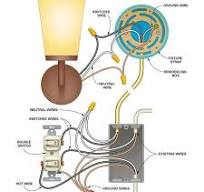Understanding how your electrical system works is crucial before you tackle installing a new light fixture. Always shut off power to the fixture at your home’s circuit breaker box. It might seem straightforward, but double-checking using a voltage tester ensures no power is running through the wires.
Safety should be your top priority. Gather the right tools, like a voltage tester, wire nuts, and a reliable ladder. It’s not just about having them; it’s using them correctly to prevent any mishaps.
Begin with removing the old light fixture. Loosen the screws and gently support the fixture with your free hand while you disconnect the wires. If it’s your first time, take a photo before disassembly. It’ll be handy to remember the original wiring setup.
Wiring can seem intimidating, but it follows a straightforward logic. Typically, black wires connect to black wires, white to white, and ground to ground. When securing the wires, make sure they’re snugly twisted together before capping with wire nuts. If the wires seem too short, consider using wire connectors for extra length.
Once the wiring’s set, position your new fixture in place. Align it with the mounting bracket and secure it with screws. It’s crucial to ensure all connections are tight to prevent wobbling.
Before packing up, test your handiwork by flipping the breaker back on and checking the switch. Making small adjustments at this stage is easier than correcting an issue later on. Look out for flickering or dim light as these are common signs of wiring issues.
Thinking about energy efficiency? It might be worth looking into fixtures that use LED bulbs. They last longer and won’t rack up your energy bill.
If things go off-track, troubleshooting might involve checking your connections or reassessing the placement of the fixture. Sometimes the box might not support your fixture’s weight; reinforcing it might be necessary.
Finally, lighting isn’t just functional—it can transform a space. Consider how the light interacts with the room. Is it warm and inviting? Does it highlight the room’s features?


Great article, Joe! I really enjoyed the step-by-step breakdown—it makes installing a new light fixture feel much less intimidating!
I do have a few questions, though:
What’s the best way to handle older wiring? Sometimes older homes have outdated wiring setups—are there any specific precautions or additional steps to take when working with them?
How can you tell if a ceiling box can support the weight of a heavier fixture, like a chandelier? Are there any signs to look for, or is it always best to reinforce it just in case?
Do you recommend any specific tools or kits for beginners? I’m curious if there’s a “must-have” toolkit for someone installing a fixture for the first time.
Also, the energy-efficient LED suggestion is awesome! Have you found any particular brands or features that work best for long-term performance and savings?
Looking forward to hearing your thoughts! Thanks for sharing such a helpful guide!
Older homes do sometimes have 2 wires (white common and black hot) the ground wire may not be present. I live in a 125 year old home and that has been the case more than not. I usually just connect to the white and black wires and connect ground wire from fixture to the metal crossbar.
If the ceiling box is metal it will be okay to handle the weight.
Tools needed are Phillips screwdriver, straight blade screwdriver, lineman pliers, wire strippers, hot stick for checking for power, and a utility knife.
I usually get my led from Amazon or Lowes just look at reviews